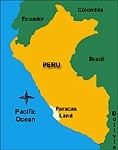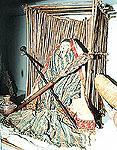Paracas Culture
Pre-Inca Culture (600 BC - 200 EC) established on the peninsula of Paracas, influencing the area which is now known as the department of Ica.
Characterized by their big, underground necropolis where bodies were preserved as mummies wrapped in luxurious cloths and mantles, forming conical bales that were conserved under excellent conditions by the characteristics of the sands of the area, and craneal trepanations. On their first stage the mummies were located in collective tombs, dug in the form of caverns. On their second stage the mummies were buried directly in the earth.
Their knowledge of medicine was advanced, just as they demonstrated, the remains of surgical operations to the brain (craneal trepanations) with the patients' survival. These people used to deform their skulls while still alive, givenig them a 'lengthened head '.
Their textile art is considered as the best of all ancient cultures. They used vicuña wool or cotton; harmonious and with many colors, animal designs, anthropomorphous and geometric, some included feathers.
Their ceramic did not reach remarkable development. Paracas ceramics, influenced by the Chavin culture, included simple shapes, with many colors and illustrations as well as drawings that are similar to the Nazca culture. The double-peaked bottles united with a handle bridge; one of these peaks was sometimes replaced with forms of heads of birds, with the shape of animals or anthropomorphous and the body painted in the bottle. They also highlighted their plates, cups and single-necked bottles. Their ceramic was made without molsd and baked in closed ovens.
Their economic activity was based on agriculture and fishing; the agrarian activity had the intelligent handling of the waters (aqueducts) on deserts, that progressed by means of artificial watering channels and use of the guano a fertilizer.
The main cultural center is located in Cerro Colorado, whithin the National Reserve of Paracas.
See Site Museum Julio C. Tello
To appreciate their invaluable ceramic pieces, textile and funeral bales you can go to the Archaeological museums o Peru, Larco Herrera, and Museo de la Nación in the city of Lima.
Paracas cemeteries
Paracas (235 Km south of Lima) is known for the beauty of the natural scenery, the richness of its funeral ritual, the quality of its textiles, and its advanced knowledge of surgery dating back to 2.500 years ago. Almost 60% of the patients who underwent cranial trepanations are estimated to have survived the operation.
In 1925, Peruvian archeologist Julio C. Tello unearthed the first remains of the Paracas civilization. Their splendid fabrics- witnessing to a rich magical vision of this civilization’s social lifewere woven in cotton, the wool of South American ruminants or a mix of both, and decorated with brightly colored embroideries in woolen thread. One of the most frequent characters is depicted as a line drawing of bird-and feline-like human beings holding a scepter, severed heads, arrows, plants and various emblems. It is variously represented in standing and flying position, looking straight ahead or to the side. The oldest Paracas human remains date back to at least 5.000 years BC, attesting to impressively continuos human habitation in an oasis and desert environment that seems to have changed little in thousands of years. Around approximately 400 BC The peninsula started to look like a gigantic cemetery. Generation after generation buried their dead in the desert sand, thus turning the area into a land of the dead. Tombs were dug deep in the shape of a bottle. A large under-ground chamber that could hold 30 to 40 individuals wrapped in fabrics was accessed through a long and narrow well. This configuration is at the origin of the Paracas Caverns name given to this stage of their evolution. Hundreds of these burials were found by Tello in the 1920s, fundamentally in the Cerro Colorado zone, near the present day Paracas site museum.
Towards 200 AD, funeral habits changed. At this new stage- Paracas Necropolis- the grouped individuals were interred at a lesser depth, frequently among the garbage in houses of former occupations, although always in funerary bundles wrapped in textiles, located one next to the other. Wari Kayan and Cabeza Larga, cemeteries of this type, provide many of the best evidence of textile art and pre-Hispanic surgery. The fabrics wrapping the buried corpses, a product of their creative work, were made of cotton using natural dyes. They are one of the most outstanding achievements of Andean techniques and aesthetics. During its complex history, the peninsula became also attractive for the inhabitants of neighboring regions. Pottery found in the Paracas Necropolis burials, specially the most recent one, shows a series of cultural patterns originated in the immediately neighboring valleys, Pisco and Chincha, area of the Topara culture.



